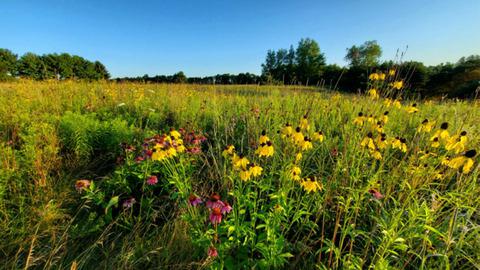当前位置:
X-MOL 学术
›
J. Appl. Ecol.
›
论文详情
Our official English website, www.x-mol.net, welcomes your
feedback! (Note: you will need to create a separate account there.)
Soil resources mediate the strength of species but not trait convergence across grassland restorations
Journal of Applied Ecology ( IF 5.0 ) Pub Date : 2021-05-21 , DOI: 10.1111/1365-2664.13929 Christopher P. Catano 1 , Tyler J. Bassett 2 , Jonathan T. Bauer 3 , Emily Grman 4 , Anna M. Groves 1, 5, 6 , Chad R. Zirbel 7 , Lars A. Brudvig 1, 6
中文翻译:

土壤资源介导物种强度,但不介导草地恢复的性状收敛
更新日期:2021-06-22
Journal of Applied Ecology ( IF 5.0 ) Pub Date : 2021-05-21 , DOI: 10.1111/1365-2664.13929 Christopher P. Catano 1 , Tyler J. Bassett 2 , Jonathan T. Bauer 3 , Emily Grman 4 , Anna M. Groves 1, 5, 6 , Chad R. Zirbel 7 , Lars A. Brudvig 1, 6
Affiliation

|
- Ecological restoration is notoriously unpredictable because similar actions can result in different outcomes. Outcomes can also differ for species and functional components of communities depending on how restoration actions and abiotic conditions alter community assembly trajectories. Quantifying variation in community trajectories across restorations for both species and traits is rare, but can help to resolve underlying assembly processes and refine strategies to maximize restoration success.
- We quantified the importance of soil resources, seed mix richness, and prescribed fire for variation in plant species and functional trait trajectories over 6 years across 20 restored tallgrass prairies in the mid-western United States. We predicted stronger convergence for traits than species, with species and trait compositions converging more across restorations on resource-poor soils and with frequent fires due to stronger abiotic filtering. In contrast, we predicted species and trait compositions would converge more slowly or diverge across restorations with resource-rich soils, with less frequent fires, and seeded with more species due to weaker filtering and more stochasticity.
- Communities generally converged over time; however, the rate of convergence was determined by soil resources, not restoration actions. Restorations converged more across resource-rich sites. In contrast to patterns of species convergence, variation in trait composition remained stable over time regardless of soil resources or restoration actions.
- The unexpected pattern of species, but not trait, convergence during community assembly appears to result from increasing dominance of a native C4 bunchgrass, Andropogon gerardii that coincides with proportional declines of other C4 grasses that share similar traits.
- Synthesis and applications. Restoration outcomes may be more predictable than typically considered. Trait compositions were stable and variation in species compositions decreased over time owing to site conditions, where resource-rich soils produced more consistent outcomes. Our study shows monitoring multiple facets of biodiversity across restorations can reveal why outcomes vary and inform broad-scale restoration planning.
中文翻译:

土壤资源介导物种强度,但不介导草地恢复的性状收敛
- 众所周知,生态恢复是不可预测的,因为类似的行动可能会导致不同的结果。根据恢复行动和非生物条件如何改变群落组装轨迹,群落的物种和功能组成部分的结果也可能不同。对跨物种和性状修复的群落轨迹变化进行量化是罕见的,但可以帮助解决潜在的组装过程并改进策略以最大限度地提高修复成功率。
- 我们量化了土壤资源的重要性、种子混合物的丰富度,并在 6 年内在美国中西部的 20 个恢复的高草草原上为植物物种和功能性状轨迹的变化规定了火。我们预测性状的收敛性比物种更强,物种和性状组成在资源贫乏土壤的恢复中收敛性更强,并且由于更强的非生物过滤而频繁发生火灾。相比之下,我们预测物种和性状组成将在资源丰富的土壤、火灾频率较低的恢复过程中收敛得更慢或发散,并且由于过滤较弱和随机性更强而播种更多物种。
- 随着时间的推移,社区通常会趋同;然而,收敛速度是由土壤资源决定的,而不是由恢复行动决定的。资源丰富的站点之间的恢复更加融合。与物种趋同的模式相反,性状组成的变化随着时间的推移保持稳定,无论土壤资源或恢复行动如何。
- 在群落组装过程中,物种(而非性状)的意外融合模式似乎是由于本地 C 4丛草Andropogon gerardii 的优势增加,这与其他具有相似性状的C 4草的比例下降相吻合。
- 合成与应用。恢复结果可能比通常考虑的更可预测。由于场地条件,性状组成稳定,物种组成的变化随着时间的推移而减少,资源丰富的土壤产生了更一致的结果。我们的研究表明,在整个恢复过程中监测生物多样性的多个方面可以揭示结果不同的原因,并为大规模恢复规划提供信息。











































 京公网安备 11010802027423号
京公网安备 11010802027423号